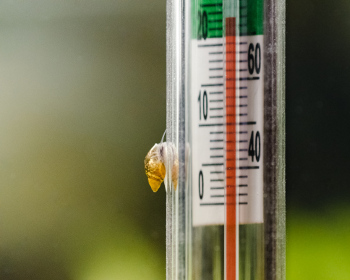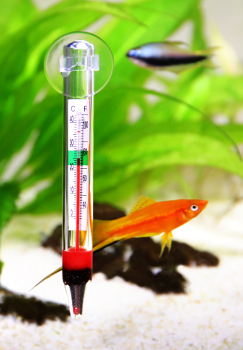Stable Water Temperature is Important for Maintaining a Beautiful, Vibrant Saltwater Aquarium
As the seasons change and cold weather arrives, keep in mind that this can negatively affect your saltwater aquarium. If you’re not careful, the water temperature in your tank can drop and turn your beautiful living work of art into a pet cemetery. In this article, we will show you why it’s important to keep the temperature in your saltwater tank stable and how you can prevent a temperature change from killing your fish.
Why is Temperature Stability Important in Saltwater Aquariums?
Most fish are cold-blooded creatures, which makes them vulnerable to changing temperatures. So not only can it harm them if the temperature gets too cold, but you should also be careful not to let it get too hot.
What Happens if the Water Temperature Gets Too Cold?
If the temperature in a saltwater aquarium drops too much, the fish will begin to slow down and show signs of lethargy. The cold will shut down their immune systems and leave them vulnerable to disease. Eventually, they will die.
What Happens if a Saltwater Aquarium Gets Too Hot?
Overheating an aquarium can also be a problem because it can make it difficult for fish to breathe. The hotter the water, the less oxygen it will dissolve. As a result, the fish will often swim to the surface gasping for air. If the water isn’t stirred or cooled down before too long, they won’t survive.
What is the Best Temperature for my Saltwater Aquarium?
While the proper temperature will vary slightly depending on the type of fish you own, it is usually best to shoot for somewhere between 76-80º F.
Whatever temperature you set your saltwater aquarium at, make sure you don’t let it fluctuate more than one or two degrees over the course of the day. Too much variance can put undue stress on your fish and lead to their untimely demise.
How Do I Keep My Water Temperature Stable?
There are many things you can do to help keep the temperature in your saltwater aquarium consistent. First, you should make sure the heater you use has the proper wattage to heat your tank. Typically, smaller tanks require higher wattages per gallon and vice versa.
Another step you can take is investing in a backup heater. Put it in the tank along with the primary heater, but set it a few degrees lower than the main one. Ideally, you’ll never have to use this secondary heater because the primary heater will keep the temperature from getting too cold, but if the first one fails, then you can rest easy knowing the secondary one will pick up its slack.
Similarly, to protect from overheating, you may also want to get a fan that will turn on if it senses your water is getting too warm.
Invest in a Thermometer
An easy way to make sure your heater never fails or gets out of hand is by purchasing a thermometer for your tank. Check the temperature throughout the day to make sure it’s staying relatively stable and not fluctuating by more than one or two degrees.
The act of checking a thermometer requires little work on your part. All you must do is glance at it every couple of hours. It will save you a lot of time and grief in the long run because you won’t have to deal with the unpleasant surprise of discovering your fish have nearly frozen or fried.
Common Mistakes to Watch Out For
Owning a saltwater aquarium in the Greater Chicago region comes with its own set of risks unique to the climate. Warmer summers make heaters less necessary. Many aquarists will turn them off to save on electric bills, which is fine during the warm months, but once winter hits they can forget to turn them back on, leading to catastrophe.
So be sure that, if you do turn your heater off during the summer, you turn it back on when it starts getting chilly. Also, remember to check that the heater is set to the correct temperature, as there’s a chance it might have reset to a default mode once you turned it off or unplugged it.
Another common mistake people make is neglecting to make sure their heaters haven’t broken down. As we mentioned above, a thermometer is the best defense against making this mistake. You could also invest in a backup heater and inspect your heater before using it.
What Do I Do If My Water Temperature Gets Too Cold?
What happens if you do make one of those mistakes and your saltwater aquarium gets too cold? The worst thing you could do is panic and try to heat the water up to normal as quickly as possible. There are many horror stories out there of people overreacting to falling tank temperatures and inadvertently killing their fish. We don’t want your experience to become another one of those!
While colder temperatures will eventually kill your fish, if the change came because of heater problems, then chances are it won’t kill your fish right away. Different fish have different reactions to temperature change. Some may die immediately while others will slowly succumb to it. The key to saving as many of your fish as possible is gradually bringing the temperature back up to normal.
Heating a tank up too fast will shock the immune systems of your fish and kill them. So, unless your water temperature has somehow dropped well below its regular temperature, there’s no need to take drastic measures to warm it back up. Instead, increase the temperature by a degree or two every couple of hours until the water temperature is back to normal.
By gradually heating the tank, you will give your fish the time they need to adjust to each temperature change and avoid shocking their systems. The same goes for if your aquarium has overheated. Whenever you need to change the temperature of your tank, always do it slowly, and you will avoid hurting your fish.
Need Help Maintaining Stable Water Temperature in Your Tank?
Many factors can negatively impact the temperature stability in a saltwater aquarium. Living Art Aquatics has been performing aquarium maintenance in Crystal Lake, IL and the Greater Chicago area for many years. We’ve seen it all and can help you prevent it all. Give us a call at (847) 737-5151, and we’ll help you give your fish the perfect water they deserve!






